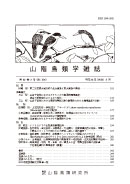43 巻, 2 号
選択された号の論文の13件中1~13を表示しています
- |<
- <
- 1
- >
- >|
総説
-
2012 年43 巻2 号 p. 105-151
発行日: 2012/03/30
公開日: 2014/03/30
PDF形式でダウンロード (3984K)
原著論文
-
2012 年43 巻2 号 p. 153-167
発行日: 2012/03/30
公開日: 2014/03/30
PDF形式でダウンロード (870K) -
2012 年43 巻2 号 p. 169-175
発行日: 2012/03/30
公開日: 2014/03/30
PDF形式でダウンロード (601K)
短報
-
2012 年43 巻2 号 p. 177-183
発行日: 2012/03/30
公開日: 2014/03/30
PDF形式でダウンロード (1664K) -
2012 年43 巻2 号 p. 184-188
発行日: 2012/03/30
公開日: 2014/03/30
PDF形式でダウンロード (2197K) -
2012 年43 巻2 号 p. 189-193
発行日: 2012/03/30
公開日: 2014/03/30
PDF形式でダウンロード (599K)
報告
-
2012 年43 巻2 号 p. 194-196
発行日: 2012/03/30
公開日: 2014/03/30
PDF形式でダウンロード (3719K) -
2012 年43 巻2 号 p. 197-201
発行日: 2012/03/30
公開日: 2014/03/30
PDF形式でダウンロード (2721K) -
2012 年43 巻2 号 p. 202-204
発行日: 2012/03/30
公開日: 2014/03/30
PDF形式でダウンロード (234K) -
2012 年43 巻2 号 p. 205-221
発行日: 2012/03/30
公開日: 2014/03/30
PDF形式でダウンロード (1423K) -
2012 年43 巻2 号 p. 222-241
発行日: 2012/03/30
公開日: 2014/03/30
PDF形式でダウンロード (1459K) -
2012 年43 巻2 号 p. 242-243
発行日: 2012/03/30
公開日: 2014/03/30
PDF形式でダウンロード (241K) -
2012 年43 巻2 号 p. 244
発行日: 2012/03/30
公開日: 2014/03/30
PDF形式でダウンロード (138K)
- |<
- <
- 1
- >
- >|
